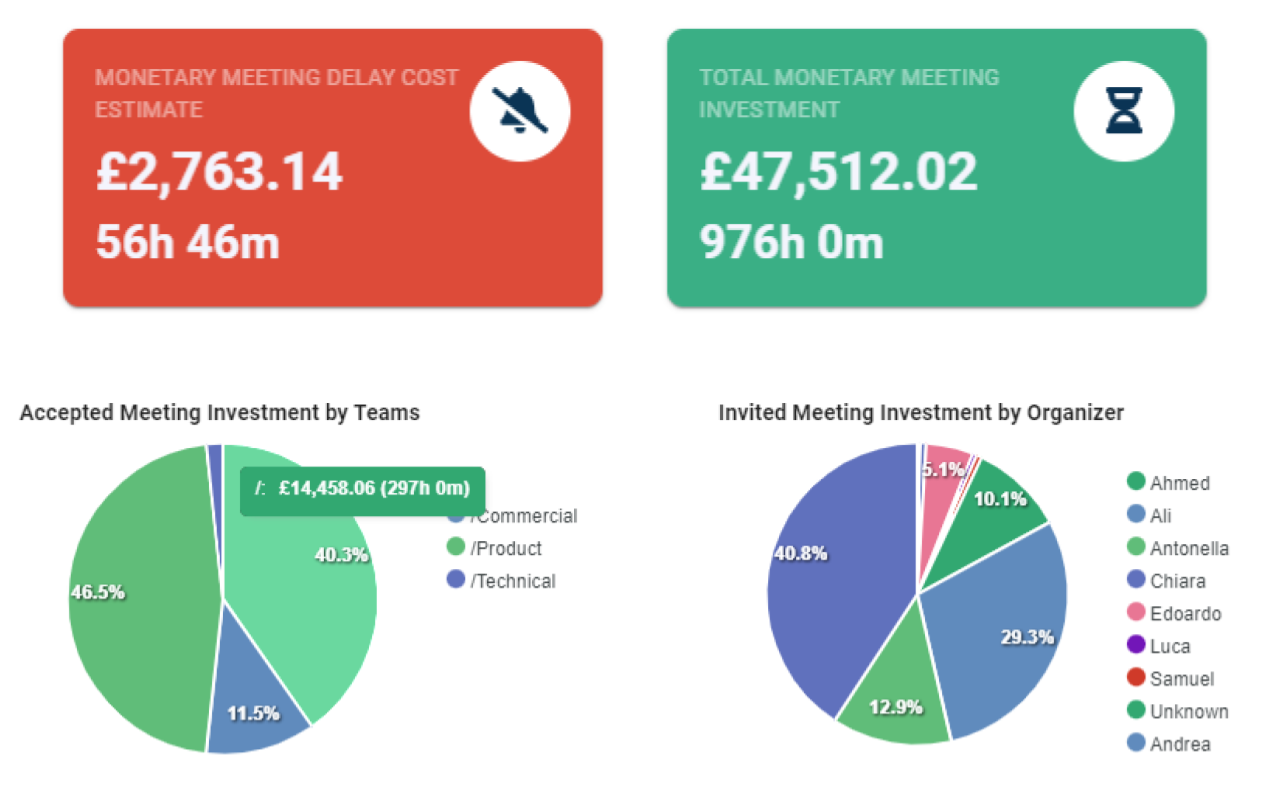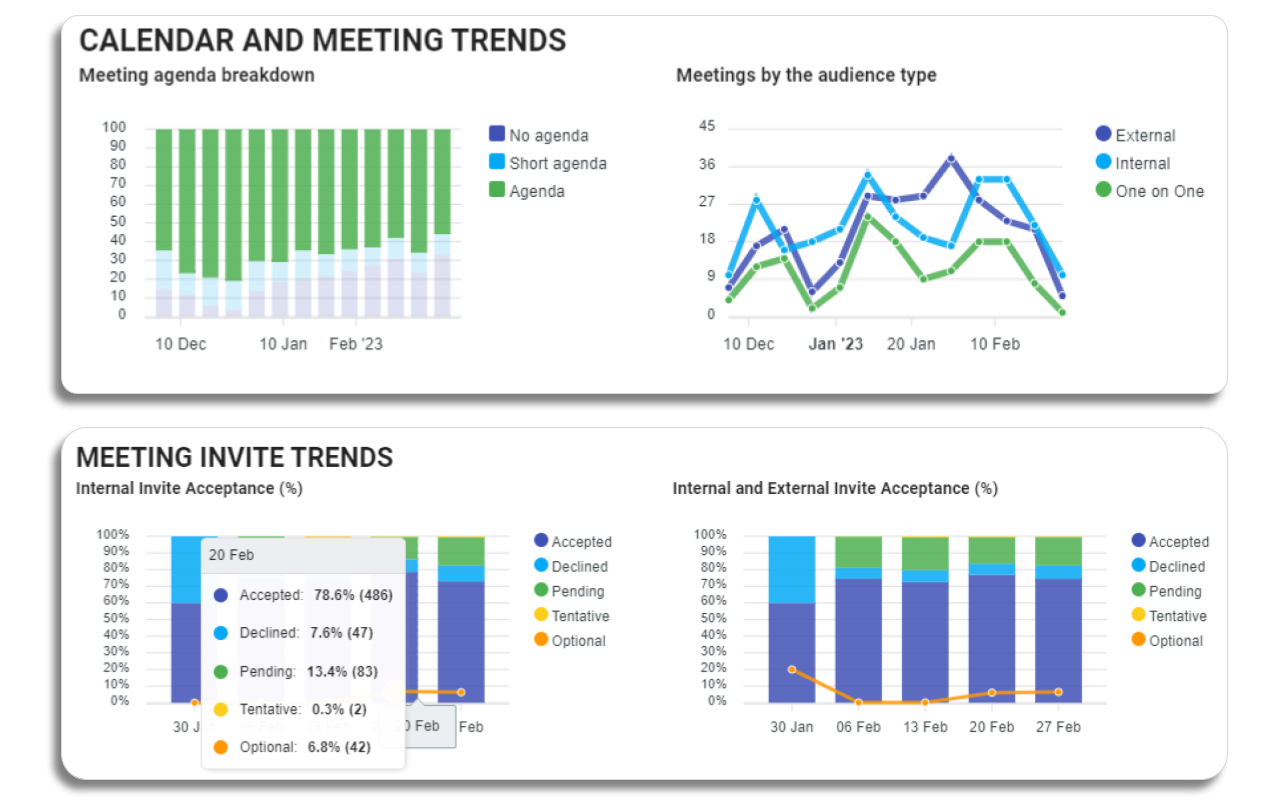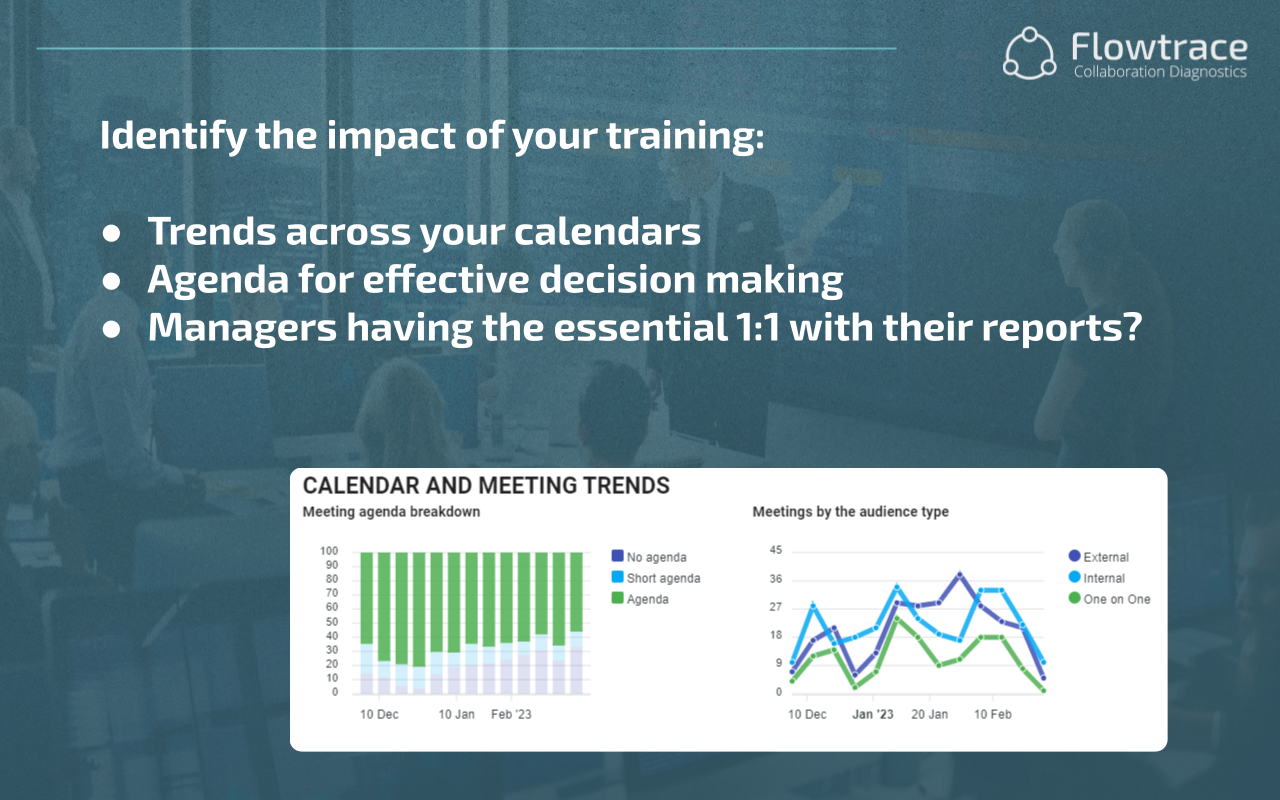Meeting Cost Calculator
Calculate meeting costs with this interactive meeting cost calculator giving you an accurate representation of how much money your meetings are...
Calculate meeting costs and reduce the $37 billion wasted annually on unnecessary meetings. Free calculator tool plus strategies to optimize meeting ROI.
Your meetings are bleeding money. Every conference room gathering, every Zoom call, every 'quick sync' is burning through your budget faster than you realize. If you're not tracking meeting costs, you're essentially writing blank checks to meeting inefficiency.
Accurately calculating meeting costs, therefore, becomes essential. It's not just about adding up the direct expenses like technology or infrastructure but also about quantifying the indirect costs such as the time spent in preparation, execution, and follow-ups.
Flowtrace shows you exactly where your meeting dollars go, and how to get them back. By integrating with an organization's existing systems, we provide a clear, data-driven picture of how meetings impact overall productivity and efficiency, empowering leaders to make informed decisions and optimize their meeting culture.
Just in case you are after a meeting cost calculator only? Here's ours:
Feel overwhelmed by the financial estimate? Just read on.
Meeting costs have spiraled out of control in 2024, reaching crisis levels that demand immediate attention. Companies now waste an estimated $37 billion annually on unproductive meetings, while employers spend approximately $29,000 per employee yearly on meeting costs. Even more shocking: companies invest around $80,000 on average in "unnecessary" meetings per employee per year. These aren't just numbers, they represent a productivity crisis hiding in plain sight.
The true cost becomes clear when you see what employees actually do in meetings: 91% of workers admit to daydreaming during meetings, while 73% work on other tasks. Employees now spend 392 hours per year in meetings, that's nearly 10 full work weeks of sitting in rooms talking instead of doing. When 45% of workers feel overwhelmed by meeting frequency, you're not just burning money, you're burning out your team.
Given these realities, it's vital for managers and executives to adopt a strategic approach to manage these costs. Accurately calculating and understanding meeting-related expenses is essential in aligning resources efficiently and fostering a productive work environment. Flowtrace can offer invaluable assistance in this regard, providing detailed analytics and insights into the true cost of meetings, thus enabling leaders to make informed decisions and optimize their meeting strategies for the betterment of the organization.
Hybrid work has created a perfect storm for meeting cost inflation. Organizations now spend approximately 15% of their time in meetings, up significantly from pre-pandemic levels. The shift to virtual meetings hasn't reduced costs, it has hidden them. Video conference fatigue, longer meeting durations to accommodate remote participants, and the technology overhead of supporting hybrid attendance all compound the financial impact. Not to talk about releasing the classic office room limiter "There's no free meeting room available". Companies that fail to account for these hidden hybrid costs are essentially flying blind with their biggest productivity expense.

Meetings, especially in the corporate world, entail a variety of costs, both direct and indirect, impacting an organization's bottom line and overall productivity. Understanding these costs is crucial for effective resource allocation and management:
These are the most visible expenses associated with meetings. They include technological infrastructure like video conferencing tools, physical meeting spaces, and materials required for the meeting. While these costs are often budgeted for, they can escalate quickly, especially with the adoption of advanced technological solutions.
The less apparent, yet more significant, are the indirect costs of meetings. Zippia reports that 24 billion hours are wasted each year due to unproductive meetings, and at least 37% of employees consider such meetings to be the highest cost to their organization. These costs encompass lost productivity, employee disengagement, and the human toll of burnout, potentially leading to employee turnover.
The cost of meetings can vary based on several factors:
Our meeting analytics play a critical role in categorizing and understanding these costs. By integrating with an organization's communication and collaboration tools, Flowtrace offers detailed insights into meeting frequency, duration, participation, and the associated costs. This data helps in identifying inefficiencies and areas for cost optimization, aligning meetings with organizational goals and productivity benchmarks.
Calculating meeting costs on a yearly, monthly, and weekly basis provides a comprehensive understanding of the financial impact of meetings. This multi-tiered approach, supported by our analytics, enables organizations to make data-driven decisions, optimizing meeting practices for cost-effectiveness and productivity.

To calculate annual meeting costs, aggregate all direct and indirect expenses incurred throughout the year. This includes technology costs, materials, and the total time spent by employees in meetings. Using Flowtrace, you can analyze the overall time spent in meetings and multiply it by the average hourly wage of participants for an accurate labor cost estimation.
Yearly Meeting Costs = (Average Hourly Wage of Participants × Total Hours Spent in Meetings Annually) + Annual Direct Costs
Additionally, consider yearly subscriptions or investments in meeting technologies. Analyzing these costs annually helps identify long-term trends and assess the effectiveness of cost-saving measures implemented throughout the year.
Monthly cost tracking is crucial for budget management and short-term financial planning. Our analytics can provide detailed monthly reports on meeting frequency, duration, and associated costs.
Monthly Meeting Costs = (Average Hourly Wage of Participants × Total Hours Spent in Meetings Monthly) + Monthly Direct Costs
These insights enable managers to identify cost-driving factors, such as recurrent unnecessary meetings, and adjust strategies accordingly. Monthly tracking also helps in forecasting future expenses and aligning them with the organization's financial goals.
Weekly analysis of meeting costs allows for agile management and immediate adjustments to avoid overspending. This entails monitoring weekly direct costs and closely observing the time employees spend in meetings. With Flowtrace, you can track these patterns and make swift modifications to reduce costs.
Weekly Meeting Costs = (Average Hourly Wage of Participants × Total Hours Spent in Meetings Weekly) + Weekly Direct Costs
In other words: Take everyone's hourly wage, multiply by meeting hours, then double it for lost productivity. Add your tech costs. That's your real annual damage.
This could involve optimizing meeting schedules, reducing the duration of regular meetings, or even cutting down on non-essential meetings. Weekly tracking is particularly useful in fast-paced environments where quick decision-making is essential for maintaining operational efficiency.
You don't have to worry about calculating meeting costs with our Meeting Cost Calculator. Created for Outlook and Google Calendar - it provides real-time calculations of meeting costs helping you identify financial drain when it comes to meeting culture.
Our advanced analytical capabilities transform how organizations approach their meeting practices. By harnessing data, leaders can make informed decisions that enhance the efficiency and effectiveness of meetings. This can include:
Effective Scheduling: Data analytics enables the optimization of meeting schedules. Flowtrace's tools can analyze peak productivity hours, frequency of meetings, and their durations to recommend optimal scheduling. This ensures that meetings are held at times when they are most likely to be productive, avoiding disruption of workflows.

Participant Selection: Strategic participant selection is another area where data proves invaluable. Our app can identify key contributors and essential personnel for various types of meetings, ensuring that only relevant stakeholders are involved. This not only saves time but also increases the effectiveness of the meetings.
Optimizing Meeting Formats: Different meeting objectives require different formats. Our analytics help in determining the most effective format – be it in-person, virtual, or hybrid – based on past meeting data. This consideration is crucial in today’s diverse working environments.
Identifying Patterns and Inefficiencies: Perhaps the most significant contribution of Flowtrace is in identifying recurring patterns and inefficiencies in meeting structures. By analyzing historical data, our app can highlight trends such as overly lengthy meetings, frequent unnecessary meetings, or recurrent scheduling conflicts.
Recognizing these patterns allows organizations to make targeted improvements, such as reducing meeting times, consolidating meeting agendas, or even eliminating redundant meetings altogether.
By leveraging data analytics from Flowtrace, you can transform company meeting culture. This leads not just to reduced costs and saved time, but also to enhanced employee satisfaction and productivity. Data-driven insights enable a more strategic, tailored approach to meetings, aligning them more closely with organizational goals and employee well-being.
Cutting meeting costs in 2025 requires AI-powered precision, not hope-based strategies. Companies using meeting analytics platforms report 25% reduction in unnecessary meetings within the first quarter. Here's what actually works: Real-time cost calculators that show dollar amounts ticking up during meetings, calendar assistants that suggest shorter durations based on agenda analysis, and automated participant optimization that removes non-essential attendees. The old advice of "set agendas" isn't enough anymore, you need data showing exactly where every dollar goes.
Here are some strategic best practices:
By adopting these practices, organizations can leverage Flowtrace to create a more efficient, cost-effective meeting culture.
Flowtrace is a prime example of how technology is revolutionizing meeting cost management. By providing detailed analytics and actionable insights, it enables data-driven decision-making, which is crucial in today's fast-paced business environment.

Smart meeting analytics and transformation platforms spot the expensive patterns you miss and fix them automatically (nearly). The use of such technologies not only optimizes resources but also aligns meeting practices with broader organizational goals, leading to enhanced overall efficiency and productivity.
Managing the costs associated with meetings is crucial for organizational efficiency and productivity. With the strategic application of Flowtrace's analytics and tools, leaders can gain invaluable insights into meeting patterns, optimize schedules, and streamline participant selection, all contributing to a more cost-effective meeting culture.
Stop guessing about meeting costs. Start measuring them. Your bottom line will thank you.
Calculate meeting costs with this interactive meeting cost calculator giving you an accurate representation of how much money your meetings are...
Improve efficiency, reduce costs, and make smarter decisions with a meeting cost calculator. Understand the financial implications and optimize...
Discover how Shopify's Meeting Cost Calculator is revolutionizing meeting culture and explore similar solutions like Flowtrace.